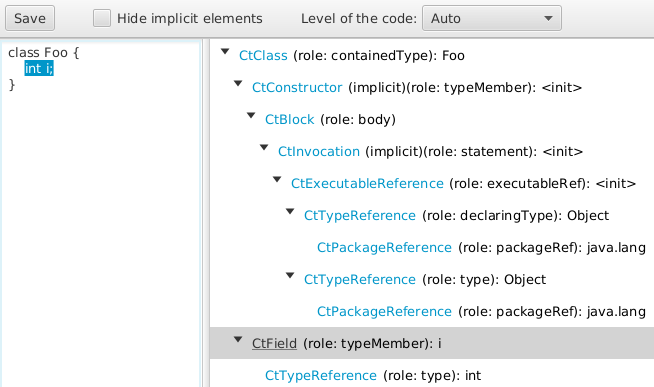Abstract Syntax Tree
An Abstract Syntax Tree, also known as ASTs, is a tree-based representation of source code. Spoon is a library to build and manipulates ASTs of Java source code.
With Spoon, you can visualize the AST of a Java file, as follows:
$ java -cp spoon-core--jar-with-dependencies.jar spoon.Launcher \
-i MyClass.java --gui

If you have Java 11 with Java FX, there is a new GUI, see https://github.com/INRIA/spoon/tree/master/spoon-visualisation

Code Analysis
Spoon is a tool for doing static code analysis at the source code level.
In Spoon, the core concept for code analysis is a processor. A processor analyzes all AST elements of a given type, one per one.
For a first processor, we’ll analyze all catch blocks of a try {...} catch {...}
element to know how many empty catch blocks we have in a project. This kind of empty
catch can be considered bad practice. That could be a great information to know how
many and where are these catches in a project to fill them with some code,
e.g. throws a runtime exception or logs the exception.
// file processors/CatchProcessor.java
package processors;
import org.apache.log4j.Level;
import spoon.processing.AbstractProcessor;
import spoon.reflect.code.CtCatch;
/**
* Reports warnings when empty catch blocks are found.
*/
public class CatchProcessor extends AbstractProcessor<CtCatch> {
public void process(CtCatch element) {
// we get all statements and if there isn't statement, it means the block catch is empty!
if (element.getBody().getStatements().size() == 0) {
getFactory().getEnvironment().report(this, Level.WARN, element, "empty catch clause");
}
}
}
This processor extends AbstractProcessor (javadoc).
This super class takes a generic type parameter to know what type you want to inspect in an AST.
For this tutorial, we inspect a catch, a CtCatch (javadoc).
When the class AbstractProcessor (javadoc)
is extended, we implement the method void process(E element)where E is a generic type for
any elements of the AST (all classes in the Spoon meta model which extends CtElement (javadoc)). It is in this method that you can access all information you want of the current CtCatch (javadoc).
Next, you can compile your processor. You can use javac in command line to generate the CatchProcessor.class file. Then we execute Spoon as follows to analyze all catch blocks in Java files that are in /path/to/src/of/your/project:
$ java -classpath /path/to/processor.jar:spoon-core--jar-with-dependencies.jar \
spoon.Launcher -i /path/to/src/of/your/project -p processors.CatchProcessor
Important:
1. Specify all dependencies in your classpath. If your processor has dependencies, don't forget to package your processor.jar with all dependencies!
2. Specify your processors in fully qualified name (here `processors.CatchProcessor`).
There are many more examples of source code analysis in https://github.com/SpoonLabs/spoon-examples.
A unique feature of Spoon is its ability to automatically transform source code, for instance for instrumentation or refactoring, see section “Transformation” below.